Philosophy Departments and Faculty Members, by Carnegie Classification and Highest Degree Offered
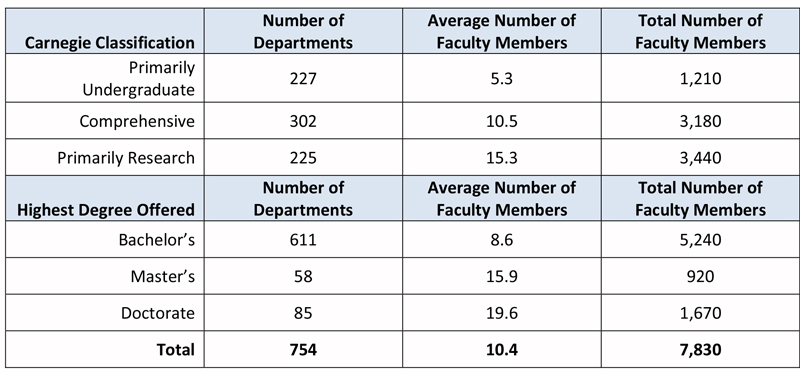
Source: Susan White, Raymond Chu, and Roman Czujko, The 2012–13 Survey of Humanities Departments at Four-Year Institutions (College Park, MD: Statistical Research Center, American Institute of Physics, 2014). Study conducted for the American Academy of Arts Sciences’ Humanities Indicators Project.
Faculty Members by Tenure Status, Fall 2012

Source: Susan White, Raymond Chu, and Roman Czujko, The 2012–13 Survey of Humanities Departments at Four-Year Institutions (College Park, MD: Statistical Research Center, American Institute of Physics, 2014). Study conducted for the American Academy of Arts Sciences’ Humanities Indicators Project.
Faculty Members by Employment Status and Gender, Fall 2012
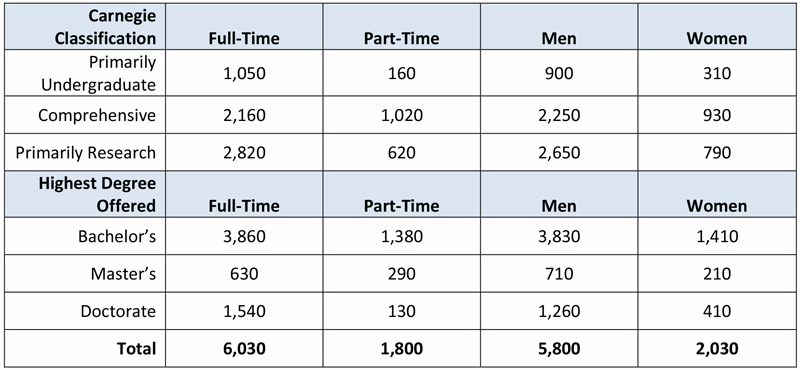
Source: Susan White, Raymond Chu, and Roman Czujko, The 2012–13 Survey of Humanities Departments at Four-Year Institutions (College Park, MD: Statistical Research Center, American Institute of Physics, 2014). Study conducted for the American Academy of Arts Sciences’ Humanities Indicators Project.
Number of Departments by Carnegie Classification and Highest Degree Offered, Fall 2012

Source: Susan White, Raymond Chu, and Roman Czujko, The 2012–13 Survey of Humanities Departments at Four-Year Institutions (College Park, MD: Statistical Research Center, American Institute of Physics, 2014). Study conducted for the American Academy of Arts Sciences’ Humanities Indicators Project.
Bachelor’s Degrees Completed in Philosophy in the 2011–12 Academic Year
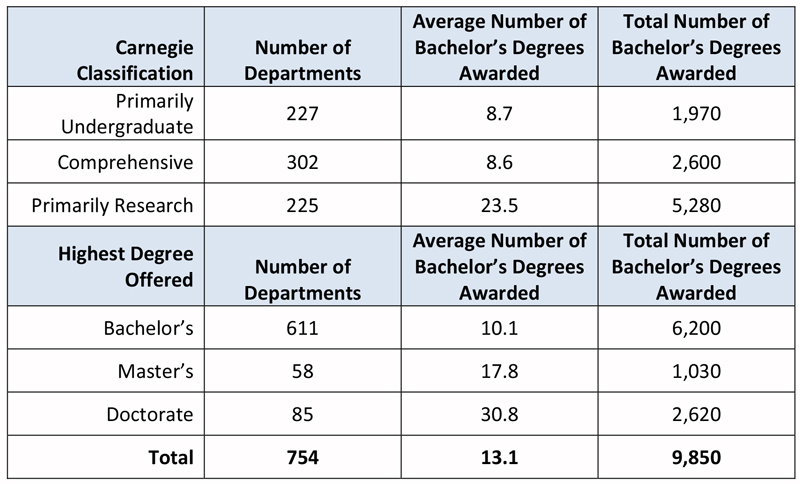
Source: Susan White, Raymond Chu, and Roman Czujko, The 2012–13 Survey of Humanities Departments at Four-Year Institutions (College Park, MD: Statistical Research Center, American Institute of Physics, 2014). Study conducted for the American Academy of Arts Sciences’ Humanities Indicators Project.
Number of Juniors and Seniors with Declared Major in Philosophy as of the Beginning of the Fall 2012 Term
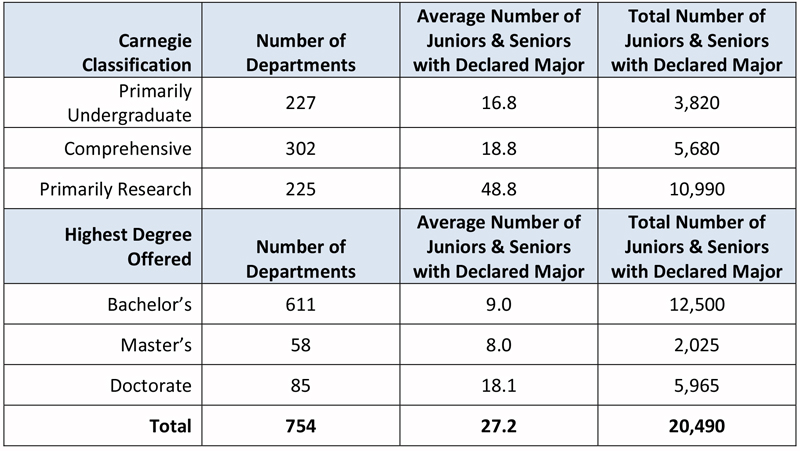
Source: Susan White, Raymond Chu, and Roman Czujko, The 2012–13 Survey of Humanities Departments at Four-Year Institutions (College Park, MD: Statistical Research Center, American Institute of Physics, 2014). Study conducted for the American Academy of Arts Sciences’ Humanities Indicators Project.
Number of Students Completing a Minor in Philosophy during the 2011–12 Academic Year
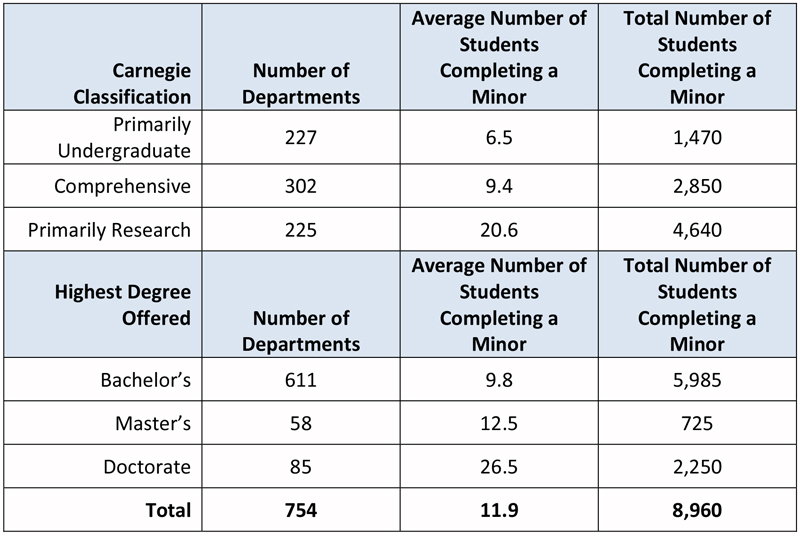
Source: Susan White, Raymond Chu, and Roman Czujko, The 2012–13 Survey of Humanities Departments at Four-Year Institutions (College Park, MD: Statistical Research Center, American Institute of Physics, 2014). Study conducted for the American Academy of Arts Sciences’ Humanities Indicators Project.
Number of Graduate Students in Philosophy during Fall 2012 Term
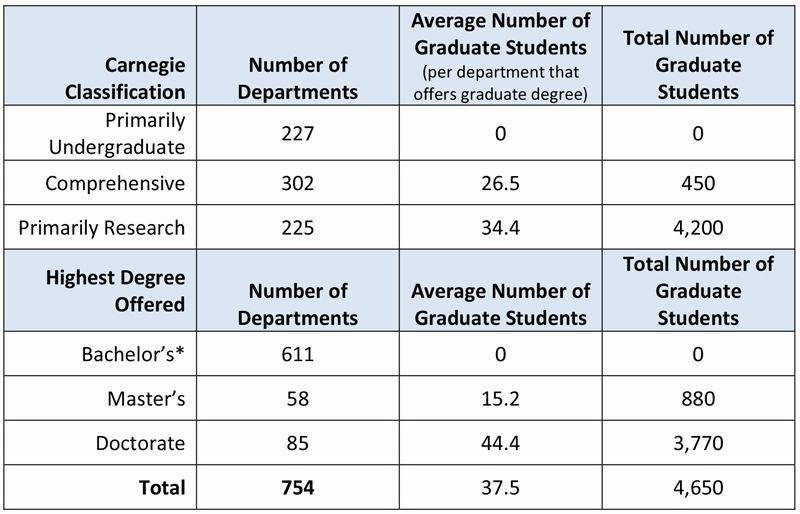
* Student figures in this row are as reported by the responding departments, none of which currently offers a graduate degree.
Source: Susan White, Raymond Chu, and Roman Czujko, The 2012–13 Survey of Humanities Departments at Four-Year Institutions (College Park, MD: Statistical Research Center, American Institute of Physics, 2014). Study conducted for the American Academy of Arts Sciences’ Humanities Indicators Project.
Source: Susan White, Raymond Chu, and Roman Czujko, The 2012–13 Survey of Humanities Departments at Four-Year Institutions (College Park, MD: Statistical Research Center, American Institute of Physics, 2014). Study conducted for the American Academy of Arts Sciences’ Humanities Indicators Project.
Instructor of Record for Introductory Undergraduate Courses in Philosophy, Fall 2012 Term
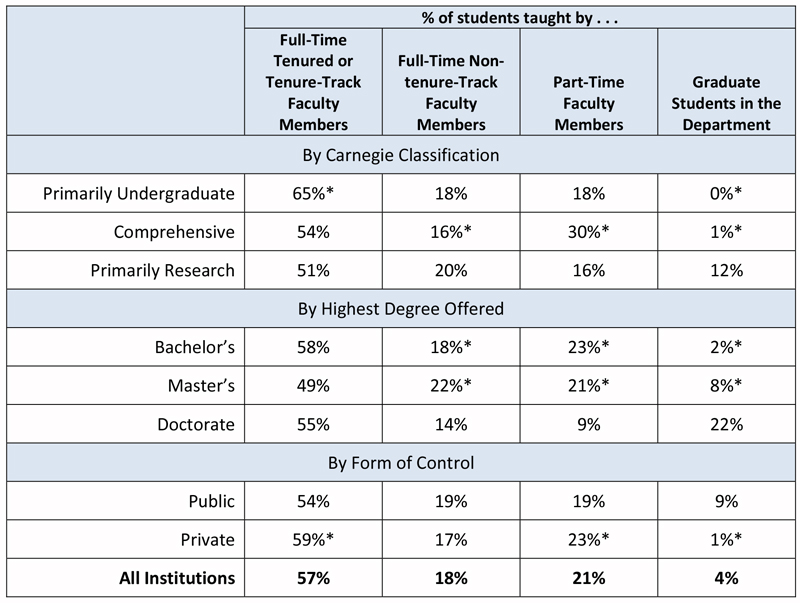
* Proportion is significantly different from Primarily Research (for Carnegie Classification) or from Doctorate (for Highest Degree Offered) or from Public (for Form of Control) at the 5% level.
We used regression analysis for these tests with a binary (0-1) variable for the level of interest. If the coefficient for the binary variable differed significantly from 0, then the interpretation from regression is that the discipline differs from all other levels combined.
Statistical significance depends on a number of factors, not solely the absolute difference between two values. While differences that are not marked as significant may seem to be the same size as, or even larger than, those marked as significant, they are not statistically significant. The most likely factors contributing to the lack of significance when the absolute difference seems “large enough” are a smaller sample size or a larger variation within that discipline.
Source: Susan White, Raymond Chu, and Roman Czujko, The 2012–13 Survey of Humanities Departments at Four-Year Institutions (College Park, MD: Statistical Research Center, American Institute of Physics, 2014). Study conducted for the American Academy of Arts Sciences’ Humanities Indicators Project.
We used regression analysis for these tests with a binary (0-1) variable for the level of interest. If the coefficient for the binary variable differed significantly from 0, then the interpretation from regression is that the discipline differs from all other levels combined.
Statistical significance depends on a number of factors, not solely the absolute difference between two values. While differences that are not marked as significant may seem to be the same size as, or even larger than, those marked as significant, they are not statistically significant. The most likely factors contributing to the lack of significance when the absolute difference seems “large enough” are a smaller sample size or a larger variation within that discipline.
Source: Susan White, Raymond Chu, and Roman Czujko, The 2012–13 Survey of Humanities Departments at Four-Year Institutions (College Park, MD: Statistical Research Center, American Institute of Physics, 2014). Study conducted for the American Academy of Arts Sciences’ Humanities Indicators Project.
Instructor of Record for All Other (Non-Introductory) Undergraduate Courses in Philosophy, Fall 2012 Term
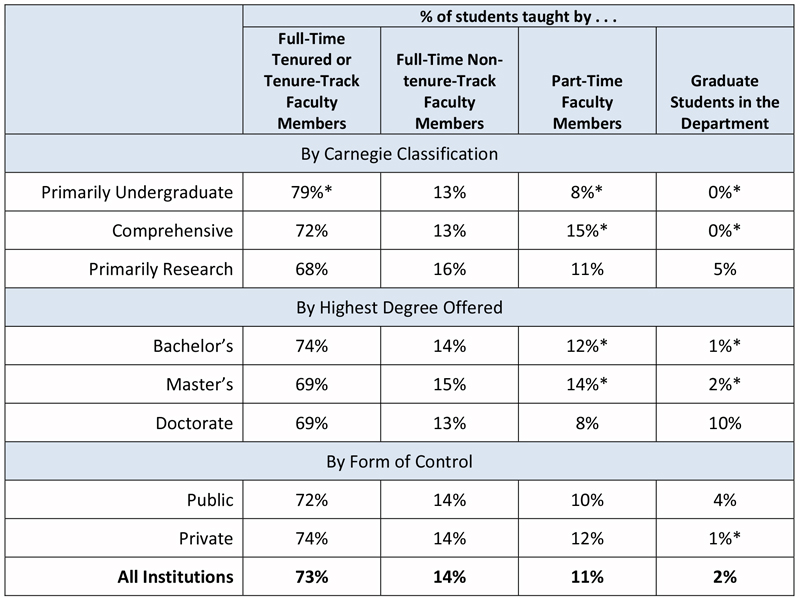
* Proportion is significantly different from Primarily Research (for Carnegie Classification) or from Doctorate (for Highest Degree Offered) or from Public (for Form of Control) at the 5% level.
** Proportion is significantly different from all other disciplines combined at the 5% level. We used regression analysis for these tests with a binary (0-1) variable for the level of interest. If the coefficient for the binary variable differed significantly from 0, then the interpretation from regression is that the discipline differs from all other levels combined.
Statistical significance depends on a number of factors, not solely the absolute difference between two values. While differences that are not marked as significant may seem to be the same size as, or even larger than, those marked as significant, they are not statistically significant. The most likely factors contributing to the lack of significance when the absolute difference seems “large enough” are a smaller sample size or a larger variation within that discipline.
Source: Susan White, Raymond Chu, and Roman Czujko, The 2012–13 Survey of Humanities Departments at Four-Year Institutions (College Park, MD: Statistical Research Center, American Institute of Physics, 2014). Study conducted for the American Academy of Arts Sciences’ Humanities Indicators Project.
** Proportion is significantly different from all other disciplines combined at the 5% level. We used regression analysis for these tests with a binary (0-1) variable for the level of interest. If the coefficient for the binary variable differed significantly from 0, then the interpretation from regression is that the discipline differs from all other levels combined.
Statistical significance depends on a number of factors, not solely the absolute difference between two values. While differences that are not marked as significant may seem to be the same size as, or even larger than, those marked as significant, they are not statistically significant. The most likely factors contributing to the lack of significance when the absolute difference seems “large enough” are a smaller sample size or a larger variation within that discipline.
Source: Susan White, Raymond Chu, and Roman Czujko, The 2012–13 Survey of Humanities Departments at Four-Year Institutions (College Park, MD: Statistical Research Center, American Institute of Physics, 2014). Study conducted for the American Academy of Arts Sciences’ Humanities Indicators Project.
Instructor of Record for All Graduate Courses in Philosophy, Fall 2012 Term
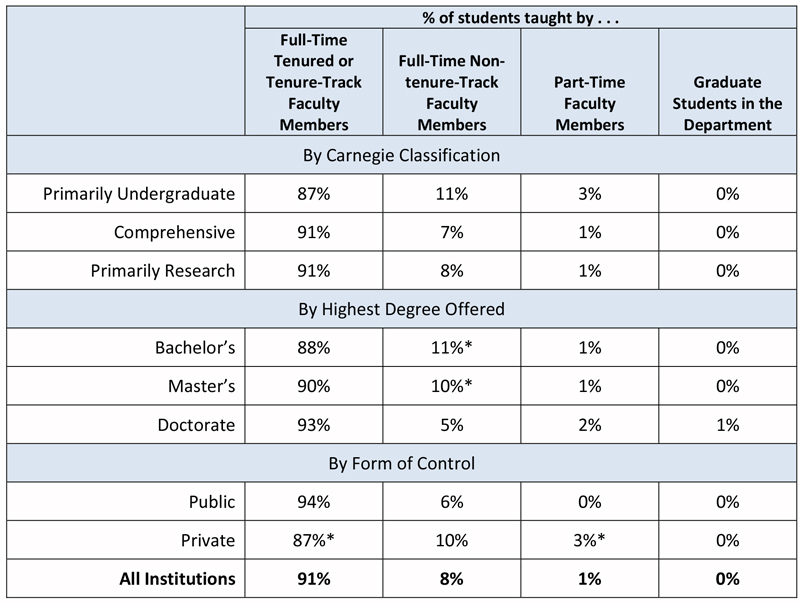
* Proportion is significantly different from Primarily Research (for Carnegie Classification) or from Doctorate (for Highest Degree Offered) or from Public (for Form of Control) at the 5% level.
** Proportion is significantly different from all other disciplines combined at the 5% level.
We used regression analysis for these tests with a binary (0-1) variable for the level of interest. If the coefficient for the binary variable differed significantly from 0, then the interpretation from regression is that the discipline differs from all other levels combined.
Statistical significance depends on a number of factors, not solely the absolute difference between two values. While differences that are not marked as significant may seem to be the same size as, or even larger than, those marked as significant, they are not statistically significant. The most likely factors contributing to the lack of significance when the absolute difference seems “large enough” are a smaller sample size or a larger variation within that discipline.
Source: Susan White, Raymond Chu, and Roman Czujko, The 2012–13 Survey of Humanities Departments at Four-Year Institutions (College Park, MD: Statistical Research Center, American Institute of Physics, 2014). Study conducted for the American Academy of Arts Sciences’ Humanities Indicators Project.
** Proportion is significantly different from all other disciplines combined at the 5% level.
We used regression analysis for these tests with a binary (0-1) variable for the level of interest. If the coefficient for the binary variable differed significantly from 0, then the interpretation from regression is that the discipline differs from all other levels combined.
Statistical significance depends on a number of factors, not solely the absolute difference between two values. While differences that are not marked as significant may seem to be the same size as, or even larger than, those marked as significant, they are not statistically significant. The most likely factors contributing to the lack of significance when the absolute difference seems “large enough” are a smaller sample size or a larger variation within that discipline.
Source: Susan White, Raymond Chu, and Roman Czujko, The 2012–13 Survey of Humanities Departments at Four-Year Institutions (College Park, MD: Statistical Research Center, American Institute of Physics, 2014). Study conducted for the American Academy of Arts Sciences’ Humanities Indicators Project.
Assessment* of Overall Undergraduate Student Learning in Philosophy as of the Fall 2012 Term
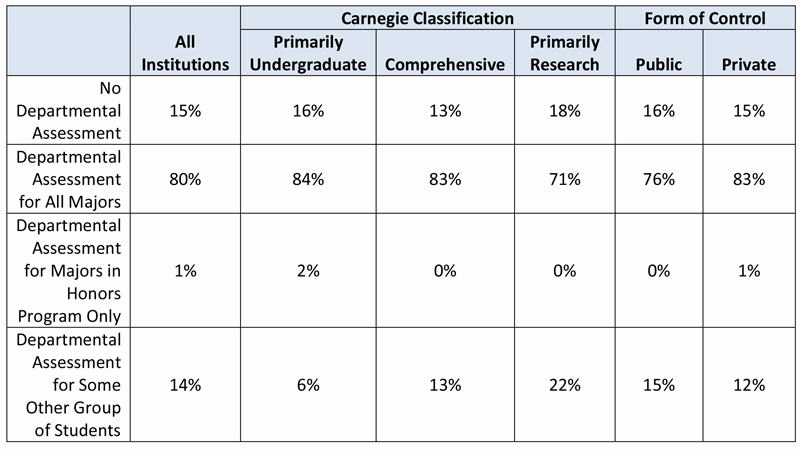
Note: The sum of the four rows in any column may exceed 100% because respondents could select multiple choices.
* The “assessment” is an aggregate assessment based on examining the results from a given cohort of students in an attempt to examine the effectiveness of a program.
Source: Susan White, Raymond Chu, and Roman Czujko, The 2012–13 Survey of Humanities Departments at Four-Year Institutions (College Park, MD: Statistical Research Center, American Institute of Physics, 2014). Study conducted for the American Academy of Arts Sciences’ Humanities Indicators Project.
* The “assessment” is an aggregate assessment based on examining the results from a given cohort of students in an attempt to examine the effectiveness of a program.
Source: Susan White, Raymond Chu, and Roman Czujko, The 2012–13 Survey of Humanities Departments at Four-Year Institutions (College Park, MD: Statistical Research Center, American Institute of Physics, 2014). Study conducted for the American Academy of Arts Sciences’ Humanities Indicators Project.
Considerations in Tenure Decisions in Philosophy, Fall 2012
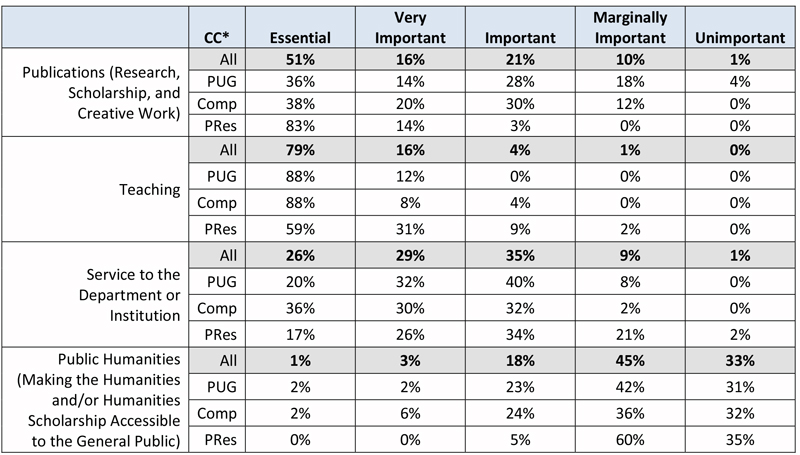
* CC—Carnegie Classification: PUG—Primarily Undergraduate, Comp—Comprehensive, PRes—Primarily Research
Source: Susan White, Raymond Chu, and Roman Czujko, The 2012–13 Survey of Humanities Departments at Four-Year Institutions (College Park, MD: Statistical Research Center, American Institute of Physics, 2014). Study conducted for the American Academy of Arts Sciences’ Humanities Indicators Project.
Source: Susan White, Raymond Chu, and Roman Czujko, The 2012–13 Survey of Humanities Departments at Four-Year Institutions (College Park, MD: Statistical Research Center, American Institute of Physics, 2014). Study conducted for the American Academy of Arts Sciences’ Humanities Indicators Project.
Faculty Tenure Decisions and New Hires
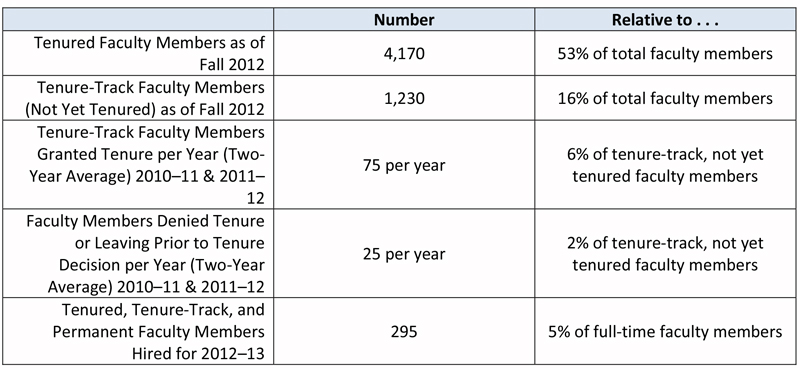
Source: Susan White, Raymond Chu, and Roman Czujko, The 2012–13 Survey of Humanities Departments at Four-Year Institutions (College Park, MD: Statistical Research Center, American Institute of Physics, 2014). Study conducted for the American Academy of Arts Sciences’ Humanities Indicators Project.
Availability of Institutional or Departmental Support for Research, Fall 2012

Source: Susan White, Raymond Chu, and Roman Czujko, The 2012–13 Survey of Humanities Departments at Four-Year Institutions (College Park, MD: Statistical Research Center, American Institute of Physics, 2014). Study conducted for the American Academy of Arts Sciences’ Humanities Indicators Project.
Philosophy Departments Offering Online Courses by Carnegie Classification and Form of Control, 2011–12 Academic Year
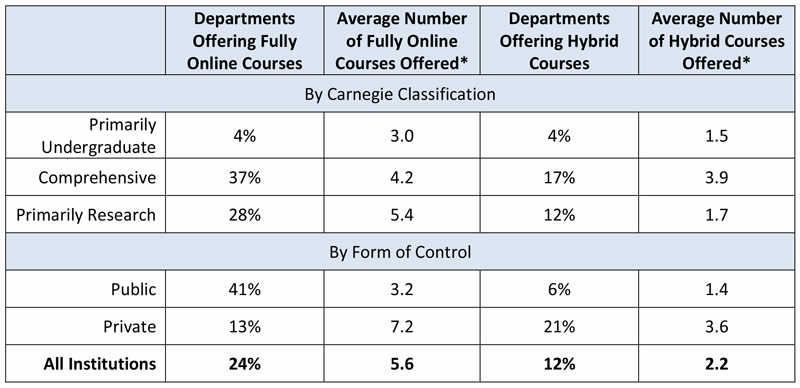
*Includes only departments that offer these courses.
Source: Susan White, Raymond Chu, and Roman Czujko, The 2012–13 Survey of Humanities Departments at Four-Year Institutions (College Park, MD: Statistical Research Center, American Institute of Physics, 2014). Study conducted for the American Academy of Arts Sciences’ Humanities Indicators Project.
Source: Susan White, Raymond Chu, and Roman Czujko, The 2012–13 Survey of Humanities Departments at Four-Year Institutions (College Park, MD: Statistical Research Center, American Institute of Physics, 2014). Study conducted for the American Academy of Arts Sciences’ Humanities Indicators Project.
Engagement with Digital Humanities by Carnegie Classification and Form of Control as of Fall 2012

Source: Susan White, Raymond Chu, and Roman Czujko, The 2012–13 Survey of Humanities Departments at Four-Year Institutions (College Park, MD: Statistical Research Center, American Institute of Physics, 2014). Study conducted for the American Academy of Arts Sciences’ Humanities Indicators Project.

